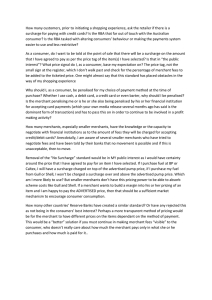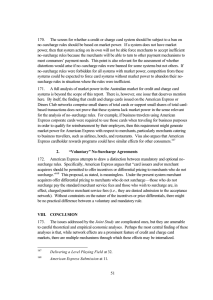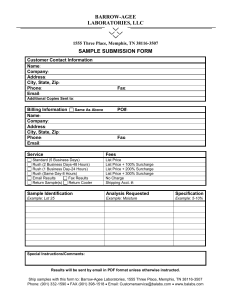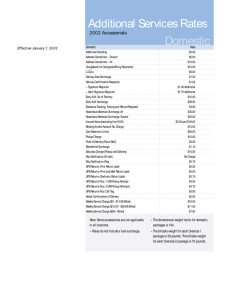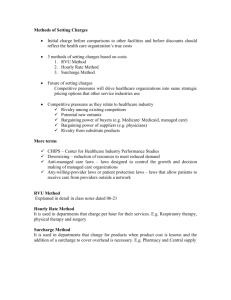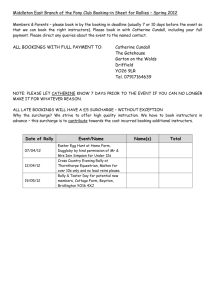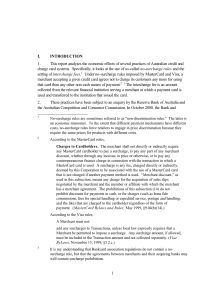Document 10842514
advertisement
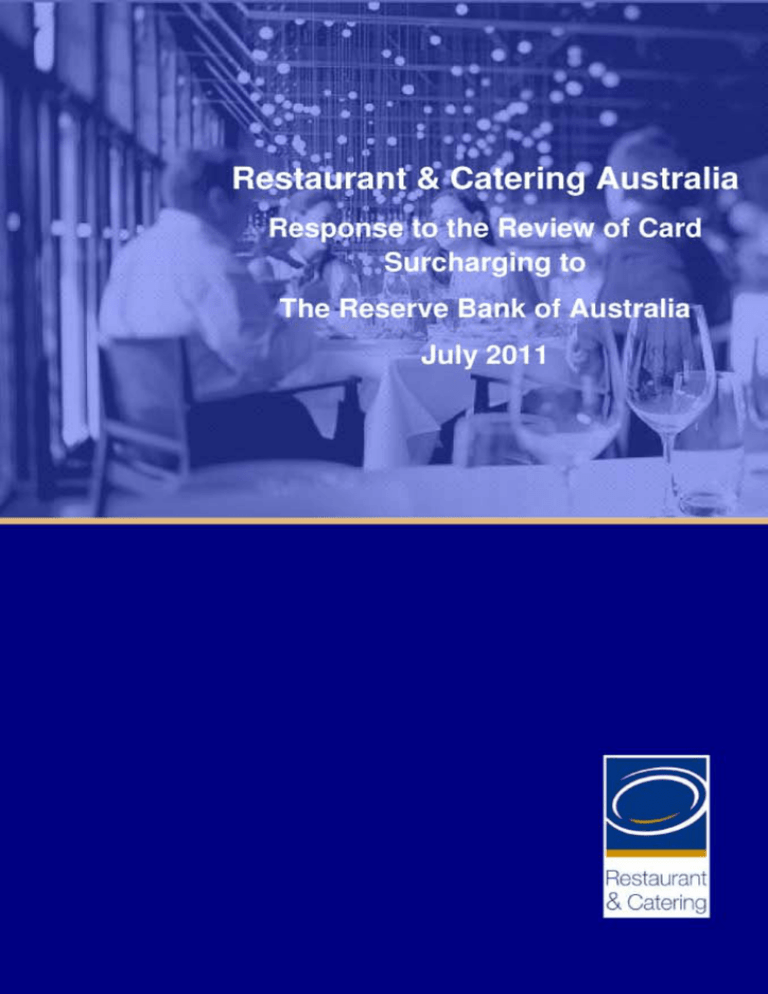
Restaurant & Catering Australia response to the Review of Card Surcharging to The Reserve Bank of Australia July 2011 Restaurant & Catering Australia (R&CA) is the only peak organisation representing the interests of the 40,000 restaurants, cafes and caterers in Australia. R&CA is thankful for the opportunity to provide a response to the Reserve Bank of Australia - Review of Card Surcharging - A Consultation Document (June 2011). According to the ABS (Retail Trade Data, for the Year to April 2011), the restaurant, café and catering sector turns over $17.8 Billion per year. Of this volume, it is estimated that the proportion of card transactions is 73% or $12.99 Billion in transactions. At the average merchant service fee of 1%, fees earned by acquirers from the restaurant industry total $130 Million per annum. From the data available it appears that credit cards tend to be more heavily used in industries with relatively high transaction sizes and where payments do not take place at the point of sale. Industries like insurance, holiday, travel and professional service sectors have around eighty (80) percent of the value of card receipts and sixty (60) percent of number of payments is accounted for by credit cards. In contrast, where the average transaction size is low, for example restaurants/fine dining, take-away and petrol outlets, EFTPOS cards are more frequently used than credit cards. Figure (i) – Debit and Credit Card Spending by Industry (RBA, 2011) All Rights Reserved 2011 © Restaurant & Catering Australia 2l Page In the preparation of this response, R&CA has completed a survey of its members; fourhundred (400) surveys were completed and returned. This is considered satisfactory given the nature of the mail-out and collection method, the length of complexity of the questionnaire, and especially, the sensitive financially-related nature of the survey. Over the same period, Choice conducted a credit card surcharge survey in conjunction with the NSW Office of Fair Trading and their results found thirty-two (32) of respondents had credit card surcharge applied when paying for meals at restaurants. Based on the Association’s survey, only fifteen (15) percent of our members apply a credit card surcharge to consumers who purchase a meal. Thirty-two (32) percent of respondents to the survey had businesses in the New South Wales, Victoria twenty-five (25) percent and Queensland nineteen (19) percent. The other states, South Australia, Western Australia and Tasmania had less than ten (10) percent responses each. Of the four hundred (400) responses, fifty-six (56) percent of respondents had businesses in the major city centres and a further thirty-nine (39) percent were considered to be regional. The Association asked respondents, for a ranking of card preference by their customers: Card Type Ranking AMEX 75 MasterCard 84 Visa Card 86 EFTPOS ATM Card 73 other 28 Mastercard and Visa were the highest rankings. According to the survey, Visa was ranked highest at 86, followed by Mastercard at eighty-four (84), AMEX was third at seventy-five (75) and cash at twenty-eight (28). This data demonstrates that most consumers prefer to use one of their credit or visa cards to pay for meals when dining. The survey also examined how many consumers pay their bills using a credit card during the week compared to the weekends. Consumers used their credit card for payment at least thirty-five (35) percent for weekend purchases compared to seventythree (73) percent of consumers using a credit card for payment. Is there a case for modifying the Standards to allow schemes to limit surcharges? R&CA does not dispute that there are merchants who have taken advantage of the ability to surcharge to recover their costs of card acceptance, to the detriment of consumers. This practice, according to our survey data, is largely found in industries where competition is in imperfect. All Rights Reserved 2011 © Restaurant & Catering Australia 3l Page R&CA believes some of its members may take advantage of the ability to surcharge and could possibly be using this method to recover costs of card acceptance to the detriment of customers. However, this number would be very low compared compared to other industries. R&CA believe that in some industries enterprises are charging higher surcharges because the merchant community has been paying a disproportionate share of cost of the credit cards. Consumers have been paying less than the true cost of services provided to them by credit card issuers. The figures in the below table, collected by R&CA survey demonstrates that approximately seventy-three (73) percent of consumers pay for their meals by credit card during the week, compared to approximately thirty-five (35) percent during the weekend. This data shows consumers prefer to pay by a credit card rather than by cash or cheque. Consumers paying by Credit Card 250 200 150 100 50 0 Figure (ii) – Proportion of Consumers Paying by Credit Card (R&CA Survey, 2011) Restaurant & Catering Australia Australia contends that the practice of applying of a surcharge of itself is not a justification for placing a limitation on the surcharge. Further, the Association has concluded, through it researching of this issue, that the market, in the restaurant, café and catering sector at least, has reached an equilibrium point where businesses that are applying a surcharge or doing so at a reasonable level. From the R&CA data it appears that the issue of blended surcharging is not being experienced in the restaurant sector. R&CA suggests that this may be a function of the reduction in merchant rates on American Express and the relatively small differential between this rate and that in the bank schemes. R&CA therefore concludes that, based on the experience in the restaurant restaurant industry there is no case for fixing or limiting surcharge rates. All Rights Reserved 2011 © Restaurant & Catering Australia 4l Page Is a surcharge cap best implemented by the Board setting a transparent and specific permissible cap that is specified in the Standards, and may then be imposed in scheme rules? Or should the Standards allow scheme rules to limit surcharges to an amount that is reasonable related, or equal to each particular merchant’s cost of card? As stated above, the Association believes that the case has not been made to limit surcharges. R&CA does not believe there is enough evidence to enable the RBA to set a cap on surcharging. Since the RBA implemented the current standard on credit card surcharging in 2003, businesses and consumers have adapted, and the market has largely come to a state of equilibrium regarding surcharging. R&CA advocate that when consumers are confronted with a surcharge, consumers will either select a different form of payment or chose to patronise other businesses. R&CA believe the level of excessive surcharging does not appear to be as prevalent as some may believe and therefore there is no justifiable reason for the RBA to amend the standards. Further, the Association is concerned that if RBA decide to amend the existing standards this may disrupt the current market place and inevitable costs to the payments industry and their merchants. Should there be some level of tolerance allowed around any surcharge cap? The evidence on surcharging is mixed with merchants with substantial market power surcharging, especially in situations where consumers have little choice of payments instruments, such as on-line travel, telephone payments and or care hire, or when there is essentially no prospect of their customers switching to alternative suppliers because of credit card surcharges. However, data from R&CA’s survey demonstrates that small businesses (in the restaurant and café sector) are less likely to surcharge than the larger competitors. Fifty-nine (59) percent of respondents stated that consumers did not complain about paying a surcharge for using a credit card when paying for a meal. Of the four-hundred (400) restaurant and café owners who responded, eighty (80) per cent state consumers paid by credit cards and twenty (20) percent paid with cash. The respondents were asked to provide details on what percentage (%) surcharge they were passing on to consumers paying by credit card. Eighty-five (85) percent of the respondents answered they did not pass on the surcharge to consumers, whilst the six (6) percent of respondents who did pass on the surcharge to members stated this was mainly to consumers who used an American Express credit card. The average value of surcharge passed on to consumer was between two (2) and three (3) percent. The respondents were asked how many consumers complained when they learned about a surcharge and a staggering sixty (60) percent did not complain about the surcharge, however when consumers were advised of the surcharge, fifty-three (53) percent of the consumers changed their preference of credit card. All Rights Reserved 2011 © Restaurant & Catering Australia 5l Page Percentage of surcharge applied to consumers credit card 5% 1%2% 3% 4% Nil surcharge Figure (iii) – Percentage of surcharge applied to a consumer’s credit card (R&CA Survey 2011) Figure (iii), demonstrates the majority of the survey respondents do not pass a surcharge fee on to their consumers. Respondents (business owners) did state they are more likely to apply a one (1) percent surcharge to Mastercard/Visa users and apply a two (2) to three (3) percent surcharge to Amex users when and if they apply a surcharge. Diners Club cards also received a surcharge fee ranging between four (4) and five (5) percent. The question posed to the respondents on ‘why do you surcharge?’ the responses were as follows: To recoup the transaction fee charged by the card provider? 57.3% To cover the transaction fee and produce additional profit? 3.6% Because legally I can? 5.5% None of the above 40.5% Of the 400 respondents, fifty-seven (57) percent passed on the surcharge to the consumer to recoup the transaction fee. It must be noted that out of 400 respondent’s eight-five (85) percent did not pass on a surcharge to the consumer and if they did pass on a surcharge it was for an AMEX card and its value was approximately two (2) percent and less than one (1) percent for Mastercard transactions. This evidence as to the difference in surcharging practice, practice, in the current market, suggests that any effort to set the surcharge in any way would require significant flexibility / tolerance. In fact, this evidence suggests that the tolerance would need to consider so many factors that the tolerance level would have to be so large that the practice of limiting the surcharge would be worthless. This is another reason why the surcharge should not be limited. All Rights Reserved 2011 © Restaurant & Catering Australia 6l Page Is the merchant service fee an appropriate measure of the cost of card acceptance (that can be applied consistently across all merchants)? There is a significant difference in the merchant service fee (MSF) being paid by businesses both across industry classifications and from industry to industry. This is, in the current system, not known to consumers but would be if the proposal to link the surcharge to the MSF is accepted. This would be very confusing for consumers. Further, in many cases, the MSF varies on the basis of what sort of card is used and is therefore different from customer to consumer. In a restaurant environment this too could be confusing for customers, particularly in situations where, at a large table, different consumers are charged different rates based on which card they use and what surcharge is able to be levied on that card (i.e a standard Visa card and a premium Visa card). The MSF is the best measure of cost to the merchant for card acceptance, however, it highly variable nature would make it a difficult rate on which to base a strict surcharging regime. Should the no-surcharge Standards clarify that, notwithstanding any surcharging cap, scheme rules cannot prohibit a surcharge that is either a blended rate for each card scheme or the cost of accepting each card within a card scheme? Are there alternative ways to allow for differential surcharging? R&CA believes blended surcharging is more of a complicated issue to due to the different costs of acceptance between card products. Cards such as AMEX negotiate directly with merchants to determine a single, all in rate for that merchant based on the volume of transactions. However credit cards issued on networks of the two dominant card schemes are subject to wide range of interchangeable rates depending on factors such as the merchants industry issuer, whether it is premium or rewards card, or whether it is an international card (as noted above). Contracts between these acquirers and their merchants may be priced either on the basis of a single blended merchant service fee or on a pass through of the interchange fees plus a mark up. In the latter case, it is very difficult for a merchant to send adequate price signals to consumers about their costs of card acceptance through a surcharge. It is argued, blended surcharge can be discriminatory to some card types as merchants inevitably charge a higher surcharge to consumers for using a particular type of card, whether it be AMEX or Diners. It is understood that dominant schemes disapprove of blended surcharging. R&C argue that the current arrangement reflects effective competition between card schemes and RBA should not depart from a position of competitive neutrality and promote any surcharge model over the others. This will unfortunately be exactly what will happen if the RBA takes action to suppress blended surcharging alone whilst leaving others intact. All Rights Reserved 2011 © Restaurant & Catering Australia 7l Page Should the no-surcharge Standards require acquirers to pass information about the merchants’ costs of acceptance for each different card type if it’s requested by the merchant? And, for those on ‘interchange-plus’ pricing, should the no-surcharge Standards require acquires to pass on information about the weighted average merchant service fee if it is requested by the merchant? If the standards change to require merchants to set surcharges, if they apply, within a tolerance of merchant service fees, the merchant should be entitled to information as to the basis of the MSF. This information is likely, however, to be meaningless to the merchant that is most concerned with their total merchant fee rather than the cost structure that underpins it. The obligation to pass this information on should stand, however, to ensure that merchants are able to satisfy themselves that these costs are not inflated by the acquirer. Is there a case for disclosure of the cost of card acceptance by merchants? Or, would it be sufficient for the Bank to collect and publish more detailed data on merchant service fees, such as the range and average of merchant service fees across merchant categories for each card scheme. R&CA believes that businesses should not be required to disclose their cost structures for merchant service fees or anything else. If the standards are changed to link surcharge rules to the MSF (which as noted above R&C believe is unnecessary), the merchant should be free to work within these parameters themselves. Mandatory reporting would only add to the cost of compliance with the rules and the cost of compliance which would also result in increased surcharge rates. Summary In conclusion, based on the survey conducted by R&CA, the Association believes surcharging on credit cards may be disproportionate in some industries, however in the restaurant industry it seems to be consistent across the board, whereby the small number (15%) of restaurants and cafes who do surcharge pass on surcharge are passing on between one (1) and three (3) percent to consumers. R&CA believes where there is an option to pay cash, (including all restaurant and café businesses) that there is no justification to further control surcharging practice. This is based on the argument that excessive surcharging is not commonplace and the nature of competition is such that the consumer is not negatively impacted. In addition, the Association is concerned that any attempt to further regulate will interrupt the balance that the market has created and add further cost to merchants. All Rights Reserved 2011 © Restaurant & Catering Australia 8l Page
